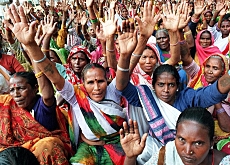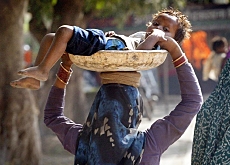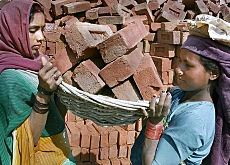Swiss lend India microfinance know-how

The Swiss government's aid agency says extending microfinance schemes to more of India's poor will not be easy, despite a pledge from the Indian authorities.
The Swiss Agency for Development and Cooperation has been active in India for more than 40 years and partners three local organisations bringing financial services to the poorest of the poor.
Microcredit refers to a small loan, the likes of which have helped would-be entrepreneurs set up businesses in mostly developing countries.
It is estimated that there are 500 million micro-entrepreneurs worldwide, who have used credit to lift themselves out of poverty.
Often lent without collateral, microcredit loans were identified by the UN as an important way of helping the poor to help themselves and to achieve the Millennium Development Goals.
These include the ambitious target of cutting extreme poverty and child mortality by half and to reverse the spread of HIV/Aids by 2015.
The current Indian government has said it will step up its efforts to reach out to the poor and that microcredit could play a vital role in alleviating poverty.
More than 60 per cent of the country’s 1.1 billion population live in rural areas and 70 per cent are dependent on agriculture but only 25 per cent of gross domestic product comes from agriculture.
“About 350 million of India’s population are classified as poor,” SDC programme officer Aniket Alam told swissinfo, adding that development in India was not reaching all levels of society.
Sufficient resources
Adrian Marti, the deputy director of the SDC’s presence in India, explained that the New Delhi government has plenty of resources at its fingertips.
“The real problem is getting people to sit down together at the same table. It’s often not done and it’s difficult to bring actors together,” said Marti.
This is where the SDC sees its role in the country. It works as a facilitator and the partnership with India has come a long way since its beginnings as a cooperation in the livestock sector.
Currently, an estimated 40 million Indians have access to microfinance, an umbrella term which refers to microcredit, savings, insurance, transfer services and other financial products for low-income clients.
Microfinance institutions (MFIs), non-governmental organisations (NGOs) and banks provide these services to a greater or lesser degree.
One big rival for these mainstream providers of microfinance is the village moneylender, who has been lending to Indian villagers for centuries.
And he continues to do good business, as one-third of the population still lacks access to mainstream financial services, despite moves in the past decades to open the door to them.
At the moneylender’s, there’s no paper trail and loans are easy to come by.
One stumbling block, though, are interest rates, which can be astronomical and lead to years of indebtedness.
“Interest rates of moneylenders can range from 78 per cent to 600 per cent [annually],” says Alam.
Local sharks
The SDC is working with three partners to open up financial services to the poor and to loosen the stranglehold that local sharks have on them.
These are: Sa-Dhan, the umbrella organisation of MFIs, the National Bank for Agriculture and Rural Development (Nabard) and the for-profit MFI Basix.
Basix, which is based in Hyderabad, is trying to prove that lending to the poor can be profitable. The SDC helped establish this organisation through a “grant” of over SFr2 million ($1.55 million) in the late 1990s.
The SDC has spent SFr220 million on its cooperation with Nabard since 1978. The latter, a state-owned organisation, has successfully linked 1.6 million self-help groups (SHGs) to banks, allowing them to open accounts and draw loans.
A SHG consists of 15-20 people (usually women) who get together as a saving circle. Once the common kitty has reached a certain size, they can approach a bank or MFI to get credit.
Sa-Dhan represents nearly 800 group members from the Indian microfinance scene and functions as an interface between the government and members, according to Achla Savyasaachi, Sa-Dhan’s policy team leader.
Challenges ahead
She says that it’s a challenging time to be a MFI in India and that the private sector has a clear role to play in helping MFIs to reach their target.
“MFIs need backers to help stop passing on costs to poor borrowers; then there are loan losses and operational costs to be covered,” Savyasaachi said.
With private banks in India breaking into the microfinance sector, MFIs are facing strong competition.
“Indian MFIs typically charge around 25 per cent interest for microcredit. Compare that to commercial banks which provide loans for between six and eight per cent,” stressed Savyasaachi.
However, mainstream banks are still reluctant to offer loans to women without collateral – in many rural areas, land, for example, is still held in the husband’s name.
And this despite the MFI experience, which show that repayment rates are high among women – ranging between 95-98 per cent.
In some areas, the MFI is imitating the moneylender, says Savyasaachi.
“They give loans for emergency situations such as medical expenses for a sick child with no paper transactions,” she said.
swissinfo, Faryal Mirza in New Delhi
On the United Nations’ Human Development Index, India is ranked 127th out of 177 countries.
However, if only its four southern states – Andhra Pradesh, Kerala, Karnataka and Tamil Nadu – were taken into account, the country would jump up 60 places, illustrating the skewed distribution of indicators of human development throughout the country.
The Swiss Agency for Development and Cooperation has been active in India for over 40 years.
It works with three local organisations to open up access for the rural poor to financial services.
These are: Sa-Dhan, the National Bank for Agriculture and Rural Development (Nabard) and the Basix.
Microfinance refers to loans, savings, insurance, transfer services and other financial products for low-income clients.
Microcredit is a small amount of money loaned to a client by an institution often without collateral.
There are some 500 million borrowers worldwide.
Microenterprises make up 80% of all businesses in developing nations.

In compliance with the JTI standards
More: SWI swissinfo.ch certified by the Journalism Trust Initiative



You can find an overview of ongoing debates with our journalists here. Please join us!
If you want to start a conversation about a topic raised in this article or want to report factual errors, email us at english@swissinfo.ch.